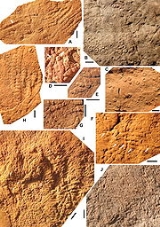
Funisia
Encyclopedia
Funisia is a genus containing the single species F. dorothea, a fossil
upright worm-like animal from the Ediacaran biota. Funisia stood about 0.3 metres tall. Because individuals grew in dense collections of animals the same age, it is believed to have reproduced sexually. Although the evolution of sex
took place before the origin of animals, and evidence of sexual reproduction is observed in red algae , Funisia is one of the oldest known animals for which there is evidence of sexual reproduction. Its relationship to other animals is unknown, but it may belong within the Porifera (sponges) or Cnidaria
. The genus and species were described in a 2008 paper.
The name dorothea is in honor of Dorothy Droser, the mother of one of the scientists to describe the animal.
Fossil
Fossils are the preserved remains or traces of animals , plants, and other organisms from the remote past...
upright worm-like animal from the Ediacaran biota. Funisia stood about 0.3 metres tall. Because individuals grew in dense collections of animals the same age, it is believed to have reproduced sexually. Although the evolution of sex
Evolution of sex
The evolution of sexual reproduction is currently described by several competing scientific hypotheses. All sexually reproducing organisms derive from a common ancestor which was a single celled eukaryotic species. Many protists reproduce sexually, as do the multicellular plants, animals, and fungi...
took place before the origin of animals, and evidence of sexual reproduction is observed in red algae , Funisia is one of the oldest known animals for which there is evidence of sexual reproduction. Its relationship to other animals is unknown, but it may belong within the Porifera (sponges) or Cnidaria
Cnidaria
Cnidaria is a phylum containing over 9,000 species of animals found exclusively in aquatic and mostly marine environments. Their distinguishing feature is cnidocytes, specialized cells that they use mainly for capturing prey. Their bodies consist of mesoglea, a non-living jelly-like substance,...
. The genus and species were described in a 2008 paper.
Etymology
The generic name Funisia is after the Latin "Rope", and is pronounced to rhyme with Tunisia, rather than the more fitting "fun is 'ere".The name dorothea is in honor of Dorothy Droser, the mother of one of the scientists to describe the animal.

